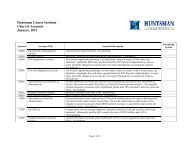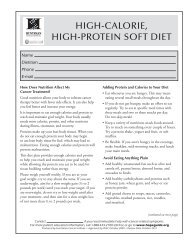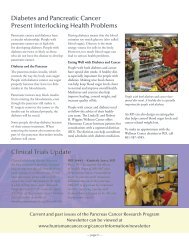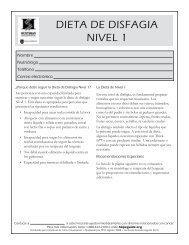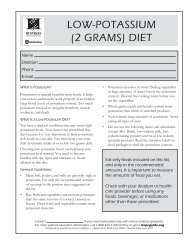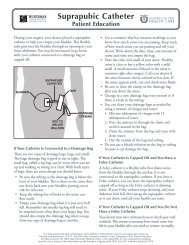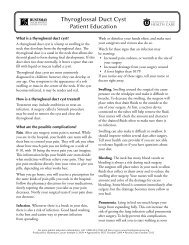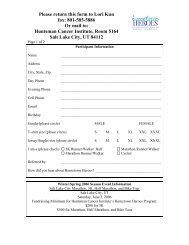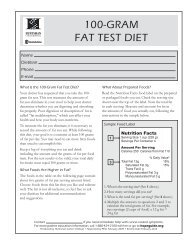Huntsman Cancer Institute Style Manual
Huntsman Cancer Institute Style Manual
Huntsman Cancer Institute Style Manual
You also want an ePaper? Increase the reach of your titles
YUMPU automatically turns print PDFs into web optimized ePapers that Google loves.
Update October 2012Publications <strong>Style</strong> Guidelines<strong>Huntsman</strong> <strong>Cancer</strong> <strong>Institute</strong> (HCI) <strong>Style</strong> Guidelines ensure consistency and professionalism in all HCI printed andelectronic communications. These guidelines incorporate nationally accepted standards of grammar, punctuation, andstyle (The Chicago <strong>Manual</strong> of <strong>Style</strong> and/or the Associated Press <strong>Style</strong>book and Briefing on Media Law). This guide doesnot address topics where correct and incorrect usage is well established; please see The Chicago <strong>Manual</strong> of <strong>Style</strong> andMerriam-Webster Dictionary, especially to determine if a word is one word, two words, hyphenated, or capitalized.Some guidelines may be overlooked to accommodate the wishes of a client. The objectives are to adhere to principles ofhealth literacy, readability, and consistency of usage within a publication. Scientific journals frequently have unique styleguidelines, which are available on the websites of those publications and should be followed in lieu of the HCIguidelines.AA Reason to Hope ® – This is a registered trademark of HCI. Its use is encouraged in print and electronic communicationmaterials. It should always be followed by a superscripted ®.academic degrees – Use bachelor’s degree or master’s degree, but bachelor of science degree or master of arts degree.(Not bachelor’s of science degree or master’s of arts degree.) Use doctoral degree or doctorate, but notdoctorate degree. Omit periods in abbreviated degrees: BA, BS, MA, MS, PhD, PharmD.See “Degrees” in the general U of U course catalog for names and abbreviations of U of U degrees. If you mustmake an abbreviation plural, add s but no apostrophe: BAs, PhDs.academic titles – Lowercase when the title is a description: Claudio Larsen, professor of anthropology. Initial capitalletter (cap) only when a formal title (not a job description) precedes a name: Associate Professor Jacob Smith inanthropology. To minimize capitalization, generally follow this order: name, rank, and department/area/college.Please note that academic titles belong with academic institutions: associate professor of medical oncology atthe University of Utah School of Medicine; not associate professor at University Health Care or associateprofessor at <strong>Huntsman</strong> <strong>Cancer</strong> <strong>Institute</strong>.acronyms – Well-known acronyms can be used on first reference: ROTC, TIAA/CREF. Spell out less immediatelyrecognizable acronyms on first reference, followed by the acronym in parentheses. On second reference, usethe acronym only.acting – Lowercase. Use initial cap on title that follows, if the title normally would have an initial cap: acting Dean BorisKuznetsov.addresses – In text, use 250 South 500 (not 5th) West. Spell out and capitalize First through Tenth when used as a streetname (Ninth, not 9th, Avenue). Spell out North (not N.) Temple and South (not S.) Campus Drive (because theyare the full names of those streets). Use the abbreviations Ave., Blvd., and St. only with a numbered address:1600 Pennsylvania Ave. Spell them out and use initial caps when part of a formal street name without a number:Pennsylvania Avenue. All similar words (alley, drive, road, terrace, etc.) are always spelled out in full. Spell outUtah except when writing an actual mailing address that requires use of the two-letter state abbreviation (UT).Check with the U.S. Postal Service or University Print and Mail Services for the latest information aboutaddressing envelopes or packages.<strong>Huntsman</strong> <strong>Cancer</strong> <strong>Institute</strong> Publications <strong>Style</strong> Guidelines 1
administration – Lowercase: the central administration, the Pershing administration.adviser – Not with an -or.African American – No hyphen. See Black or African American entry.AIDS – All uppercase because it’s an acronym. Not necessary to spell out on first reference. See also HIV entry.AirMed – One word, with uppercase M.Alaskan Native – Initial caps. Term for racial/ethnic group used by the U.S. government and the U of U’s Office of EqualOpportunity and Affirmative Action.alma mater – Lowercase.alumni, alum – Use alumni (formal plural) or alums (informal plural) or alum (singular).When identifying University alumni, use degree and class year (without periods in the degree abbreviations,without commas around the degrees, and without a space between the degree and year abbreviations): LaDawnSmith Jones BA’60 MA’63; Martin Gomez BS’75 PhD’80. Note the direction of the apostrophe. When it’s notpossible to find out a person’s degree, use just the class year—the first class year in the case of multiple degrees:Darnell Harris ’75. See also degrees entry.To aid recognition of a person whose last name has changed since graduation (with a marriage, for example),use the married and maiden names, if appropriate: LaDawn Smith Jones BA’60 MA’63.a.m., p.m. – Lowercase, with periods but no spaces. When writing 12 p.m., use “noon”; 12 a.m. use “midnight,” but not“12 noon” or “12 midnight.” If the time is on the hour, do not include :00 with the hour when using a.m. or p.m.:use “5 p.m.” not “5:00 p.m.” Obviously, when the time is not on the hour, the colon and minutes should beincluded: “2:35 a.m.”American Indian – Initial caps. Term for racial/ethnic group used by the U.S. government and the U of U’s Office of EqualOpportunity and Affirmative Action.ampersand (&) – Use only when it is part of an organization’s formal name; otherwise, use and in text. Not used, forexample, in full names of U of U departments.archaeology – Not archeology.Asian – Initial cap. Term for racial/ethnic group used by the U.S. government and the U of U’s Office of EqualOpportunity and Affirmative Action. Also, Asian is preferred over Oriental for inhabitants of the Far East nationsof Asia and nearby islands.associate degree – Not associate’s degree (unlike bachelor’s below).attribution – Use present tense (he says, she says) unless the reference is specifically time-related.<strong>Huntsman</strong> <strong>Cancer</strong> <strong>Institute</strong> Publications <strong>Style</strong> Guide 2
Bbachelor’s – Use an apostrophe (possessive) when referring to the degree: bachelor’s program, bachelor’s degree, abachelor’s in communication.Black or African American – Initial caps. Term (all four words as a unit) for racial/ethnic group used by the U.S.government and the U of U’s Office of Equal Opportunity and Affirmative Action.Board of Trustees, Board of Regents – Lowercase on second reference when omitting board: to the trustees, from theregents.breast self-examination – see self-examination entry.C<strong>Cancer</strong> Center – Sometimes used in reference to HCI as a National <strong>Cancer</strong> <strong>Institute</strong>-Designated <strong>Cancer</strong> Center,particularly in <strong>Cancer</strong> Center Support Grant (CCSG) documents: Our <strong>Cancer</strong> Center has 135 members.capitalization – Avoid unnecessary capital letters. Too many capitals detract from your message by slowing anddistracting the reader. Use a capital letter only when principles in this style guide or other references justifydoing so. See professional titles entry.Caucasian – Initial cap. Term for racial/ethnic group used by the U.S. government and the U of U’s Office of EqualOpportunity and Affirmative Action.CD-ROM – All uppercase because it’s the acronym for compact disc acting as a read-only memory device. CD-ROM disc isredundant.chair – Use it as a noun and as a verb: He is the committee chair. She chairs the committee. Don’t hyphenate: She is vicechair not She is vice-chair.check-in – Two words, hyphenated when used as a noun or adjective: The patient check-in desk is left of the lobby. Twowords, no hyphen when used as a verb: Please check in at the desk.checkup – One word when used as a noun: The patient scheduled her checkup for late in the afternoon.clinical trial phases – Capitalize P in Phase and use Roman numerals.The Phases of Clinical TrialsPhase I trial: The first step in testing a new treatment in humans. These studies test the best way to give a newtreatment (for example, by mouth, intravenous infusion, or injection) and the best dose. Because little is knownabout the possible risks and benefits of the treatments being tested, Phase I trials usually include only a smallnumber of specific patients.Phase I/II trial: A trial to study the safety, dosage levels, and response to a new treatment.Phase II trial: A study to test whether a new treatment has an anticancer effect (for example, whether it shrinksa tumor or improves blood test results) and whether it works against a certain type of cancer.Phase III trial: A study to compare the results of people taking a new treatment with the results of people takingthe standard treatment (for example, which group has better survival rates or fewer side effects). In most cases,studies move into phase III only after a treatment seems to work in phases I and II. Phase III trials may includehundreds of people.<strong>Huntsman</strong> <strong>Cancer</strong> <strong>Institute</strong> Publications <strong>Style</strong> Guide 3
Phase IV trial: After a treatment has been approved and is being marketed, it is studied in a phase IV trial toevaluate side effects that were not apparent in the phase III trial. Thousands of people are involved in a phase IVtrial.college names – Initial cap for the formal name of a U of U college: College of Law, School of Medicine, Graduate Schoolof Social Work. Lowercase for informal references: the law school, the medical school.colons to introduce a list – Do not use a colon to introduce a list (bulleted or otherwise) if the list is the complement orobject of an element in the introductory statement. The store has bread, eggs, yogurt, and milk. (no colon after“has” since the list is the object of the introductory statement) The store offers many items: bread, eggs, yogurt,and milk. (colon after “items” since the introductory statement is complete).A common misuse: using a colon after “includes.” My grocery list includes bread, eggs, and milk. (no colon afterincludes) My grocery list includes the following: bread, eggs, and milk. (do use a colon after “the following.”)commas – Use the last comma in a series before and. Example: red, white, and blue (not red, white and blue). For othercomma usage, consult The Chicago <strong>Manual</strong> of <strong>Style</strong> and Merriam-Webster Dictionary.computers – Beginning with first reference, a personal computer is a PC, plural PCs (lowercase s and no apostrophe).curriculum, curricula – Curriculums for the plural is the dictionary’s second—less preferred—option.Ddash – A punctuation mark that is longer than a hyphen. The two most common are the en dash (–) andem dash (—). The en dash (about the length of the letter “n”) is used in ranges such as ages 5–7 years and times1–2 p.m. The em dash (about the length of the letter “m”) indicates a parenthetical thought in the middle of asentence—like this—and can also indicate an unfinished sentence, similar to the use of an ellipsis. Both the enand em dash are used without spaces on either side.database – One word.dean – Initial cap when used as a formal title before a name (least preferred method): Dean Gloria Chang, Deans GloriaChang and Jason Martinez. Lowercase in other uses: Gloria Chang, dean of the college; the dean.Department, clinic, and program names – Spell out and initial cap the proper names of all HCI departments, programs,and clinics on the first reference within a document. If it will be referenced more than once, include theacronym within parentheses, and use the acronym for subsequent references. For example, <strong>Huntsman</strong> <strong>Cancer</strong>Learning Center (CLC).The following are departments, clinics, and programs at HCI:Acute Care Clinic (ACC)Blood and Marrow Transplant (BMT) ProgramBrain Tumor ProgramBreast <strong>Cancer</strong> Program<strong>Cancer</strong> Center Support Grant (CCSG) Research Programs<strong>Cancer</strong> Control and Population Sciences (CCPS)Cell Response and Regulation (CRR)Colon <strong>Cancer</strong> (CC)<strong>Huntsman</strong> <strong>Cancer</strong> <strong>Institute</strong> Publications <strong>Style</strong> Guide 4
Imaging, Diagnostics, and Therapeutics (IDT)Nuclear Control of Cell Growth and Differentiation (NC)Center for Children’s <strong>Cancer</strong> Research (C3R)Center for Investigational TherapeuticsClinical Trials Office (CTO)Communications, Office ofPrint CommunicationsWeb CommunicationsComputing and Technology Group (CATG)Director’s Translational Research Initiative (DTRI)Environmental ServicesFacial ProstheticsFacilities and OperationsFamily <strong>Cancer</strong> Assessment Clinic (FCAC – part of High Risk <strong>Cancer</strong> Research Clinics and Studies)Finance DepartmentFlow Cytometry (FC) – see also Shared ResourcesFluoresence Microscopy (FM) – see also Shared ResourcesGastrointestinal <strong>Cancer</strong> ProgramHepatobiliary <strong>Cancer</strong> Research Program – part of High Risk <strong>Cancer</strong> ResearchPancreas <strong>Cancer</strong> Research Program – part of High Risk <strong>Cancer</strong> ResearchGenetic Counseling – part of High Risk <strong>Cancer</strong> Research; see also Shared ResourcesGenome Sciences Program in the Bioscience Graduate Study ProgramGift ShopGlass Wash FacilityGynecology <strong>Cancer</strong> ProgramHCH4 – <strong>Huntsman</strong> <strong>Cancer</strong> Hospital inpatient 4 th floorHCH5 – <strong>Huntsman</strong> <strong>Cancer</strong> Hospital inpatient 5 th floorHICU – <strong>Huntsman</strong> <strong>Cancer</strong> Hospital intensive care unitHead and Neck <strong>Cancer</strong> ProgramHematology <strong>Cancer</strong> ProgramHereditary Gastrointestinal <strong>Cancer</strong> Registry (HGCR) – part of High Risk <strong>Cancer</strong> ResearchHuman Resources Department<strong>Huntsman</strong>-Intermountain <strong>Cancer</strong> Care Program (HICCP)<strong>Huntsman</strong> <strong>Cancer</strong> <strong>Institute</strong> Clinic at South Jordan Health CenterHigh Risk <strong>Cancer</strong> Research (HRCR) Clinics and StudiesFamily <strong>Cancer</strong> Assessment Clinic (FCAC)Genetic Counseling – see also Shared ResourcesGastrointestinal <strong>Cancer</strong>s ResearchHepatobiliary <strong>Cancer</strong> Research Program<strong>Huntsman</strong> <strong>Cancer</strong> <strong>Institute</strong> Publications <strong>Style</strong> Guide 5
Hereditary Gastrointestinal <strong>Cancer</strong>s Registry (HGCR)Pancreas <strong>Cancer</strong> Research ProgramHigh Risk Breast <strong>Cancer</strong> Clinic (note no hyphen on high risk)Skin <strong>Cancer</strong>s ResearchMelanoma Research Registry (MRR)Tom C. Mathews Jr. Familial Melanoma Research ClinicInformatics – see Research InformaticsInfusion CenterLabsAngus-Hill Lab (Melinda Angus-Hill)Ayer Lab (Don Ayer)Beckerle Lab (Mary Beckerle)Bernard Lab (Phil Bernard)Bhaskara Lab (Srividya Bhaskara)Burt Lab (Randall Burt)Cairns Lab (Brad Cairns)Chandrasekharan Lab (Mahesh Chandrasekharan)Deininger Lab (Michael Deininger)Engel Lab (Michael Engel)Graves Lab (Barbara Graves)Grossman Lab (Doug Grossman)Holmen Lab (Sheri Holmen)Jensen Lab (Randy Jensen)Jette Lab (Cicely Jette)Jones Lab (Dave Jones)Leachman Lab (Sancy Leachman)Lessnick Lab (Stephen Lessnick)Oliver Lab (Trudy Oliver)Rosenblatt Lab (Jody Rosenblatt)SARC Lab – Sarcoma Array Research Consortium (Lor Randall)Schiffman Lab (Joshua Schiffman)Sharma Lab (Sunil Sharma)Stewart Lab (Rodney Stewart)Tavtigian Lab (Sean Tavtigian)Topham-Stafforini Lab (Matt Topham and Diana Stafforini)Trede Lab (Nick Trede)Ullman Lab (Katharine—Katie—Ullman)VanBrocklin Lab (Matt VanBrocklin)A. Welm Lab (Alana Welm)B. Welm Lab (Brian Welm)Linda B. and Robert B. Wiggins Wellness-Survivorship Center (Wellness-Survivorship Center on secondreference; part of Supportive Oncology and Survivorship)Lung <strong>Cancer</strong> ProgramMelanoma and Cutaneous Oncology ProgramTom C. Mathews Jr. Familial Melanoma Research Clinic (FMRC) – part of High Risk <strong>Cancer</strong> ResrchMelanoma Research Registry (MRR) – part of High Risk <strong>Cancer</strong> ResearchMicroarray and Genomic Analysis (MGA) see Shared Resources<strong>Huntsman</strong> <strong>Cancer</strong> <strong>Institute</strong> Publications <strong>Style</strong> Guide 6
Molecular Imaging ProgramCyclotron OperationsMultiple Myeloma Program – part of the Blood and Marrow Transplant ProgramNutrition Care Services – part of Supportive Oncology and SurvivorshipOutpatient Clinics1A, 2B, 2C, 2D, 2E, 3APain Medicine and Palliative Care – part of Supportive Oncology and SurvivorshipPatient and Public Education (PPE) Department<strong>Huntsman</strong> <strong>Cancer</strong> Learning Center – may also be referenced as <strong>Cancer</strong> Learning Center (CLC),then CLC on second referenceCommunity Outreach and Prevention Education (COPE)Patient Navigation (PN—service for Spanish-speaking patients)Patient and Family Support Services – part of Supportive Oncology and SurvivorshipPediatric <strong>Cancer</strong> Late Effects Clinic – part of Supportive Oncology and SurvivorshipPedigree and Population ResourcePharmacyUtah Population Database (UPDB)Outpatient Retail PharmacyPrevention and Outreach ProgramPurchasing DepartmentRadiation OncologyResearch Administration, Office ofResearch Informatics (not Informatics) see also Shared ResourcesSarcoma Array Research Consortium (SARC) Lab – see LabsSarcoma ServicesShared ResourcesFlow Cytometry (FC)Fluoresence Microscopy (FM)Genetic Counseling (GC)Microarray and Genomic Analysis (MGA)Research Informatics (RI)Study Design and Biostatistics Center (SDBC)Tissue Resource and Applications Core (TRAC)Utah Population Database (UPDB)Special PopulationsSpecial Populations Outreach Native American (SPONA); or Native American OutreachStudy Design and Biostatistics Center (SDBC) see Shared ResourcesSupportive Oncology and SurvivorshipLinda B. and Robert B. Wiggins Wellness-Survivorship CenterAcupunctureBone Health and Osteoporosis Program<strong>Huntsman</strong> <strong>Cancer</strong> <strong>Institute</strong> Publications <strong>Style</strong> Guide 7
Fertility and Sexual HealthFitness ProgramNutrition Care Services (dietitians)Pediatric <strong>Cancer</strong> Late Effects ClinicYourStory ProgramPain Medicine and Palliative CarePatient and Family Support Services (social work)Spiritual Care Services (chaplain)The Bistro – Use full donor name on first reference: Sheila S. and David P. Gardner BistroThe Point Restaurant and Reception Center, or The PointTissue Resource and Applications Core (TRAC) see Shared ResourcesUrology <strong>Cancer</strong> ProgramUtah <strong>Cancer</strong> Registry (UCR)Utah Population Database (UPDB) see Shared ResourcesWellness-Survivorship Center (Second reference only. See Linda B. and Robert… above)disease – When referring to a specific disease or syndrome, lowercase all elements, as in hereditary non-polyposis coloncancer, unless the disease is named for someone, usually the person who discovered it, as in Ewing sarcoma orLynch syndrome. Note when writing “disease” or “syndrome” it is always lowercase. See also eponymous diseasenames entry.Disease-Oriented Teams (DOTs) – Term for groups at HCI not associated with the CCSG. Includes the following:Breast <strong>Cancer</strong>Melanoma and Cutaneous OncologyPediatric <strong>Cancer</strong>sDr. – see professional titles entry.Donor-named spaces – Programs, areas, or rooms with a formal donor name must always include that donor name onfirst reference. These spaces include the following:Cleone Peterson Eccles Center for Breast Health (hospital 3rd Floor)Tom and Wilma Panos and Family Waiting Room (hospital 2nd floor)Sheldon W. and Sandra R. Urlik Nurse Stations (hospital 4th floor)Foster Charitable Foundation Center for Investigational Therapeutics Given by Kent Foster (hospital 1st floor)<strong>Huntsman</strong> Hometown Heroes – Therapy Services Waiting Room (hospital 1st floor)Swing for Life Foundation – Patient Education Room (hospital 2nd floor)Jodie E. and Ron A. Smart Dining Room (6th floor, The Bistro) Given by Jodie and Ron Smart and the WON-DOORCorporationGail and Larry H. Miller Hospital Wing (hospital 1st floor)LOTOJA - Wellness-Survivorship Center Therapy Services Waiting Room (hospital 1st floor)Bridge - A gift from the students at the University of Utah through the Rock the U Dance MarathonSheila S. and David P. Gardner Bistro (The Bistro on second reference)Linda B. and Robert B. Wiggins Wellness-Survivorship CenterElyse Pantke White Chapel and Meditation Room<strong>Huntsman</strong> <strong>Cancer</strong> <strong>Institute</strong> Publications <strong>Style</strong> Guide 8
Eellipsis – Written as three periods with a space on either side ( ... ).e-mail – Lowercase, with hyphen. Short form of electronic mail. In dictating e-mail addresses, the “@” is pronounced“at,” the “_” is pronounced “underscore,” and the “~” is pronounced “tilde.” When used in a sentence,punctuate as usual (e.g., if the e-mail address ends the sentence, end with a period).e-mail signature – Avoid color and non-standard fonts in e-mail signatures. Follow this suggested format:NameTitleDepartment<strong>Huntsman</strong> <strong>Cancer</strong> <strong>Institute</strong> [or <strong>Huntsman</strong> <strong>Cancer</strong> Hospital]University of Utah [or University of Utah Health Care]2000 Circle of Hope, Room XYZ [or 1950 Circle of Hope, Room XYZ]Salt Lake City, Utah 84112Phone numbersE-mail Addressemphasis – To emphasize text, use bold or italics, not underlining.eponymous disease names – Medical and scientific writing tends toward dropping the possessive s at the end ofdiseases originally named after their discoverers (e.g., Down Syndrome rather than Down’s Syndrome). ConsultMerriam Webster’s Dictionary for common usage.External Advisory Board – The group that evaluates the scientific merit of HCI’s research programs (previously called theScientific Advisory Board). Use EAB on second reference.FFAQ – All uppercase because it’s the acronym for frequently asked questions. Spell out on first reference in text. Plural isFAQs, no apostrophe.fax – Lowercase. It’s not an acronym; it’s short for facsimile.fewer – Use fewer (not less) for individual items—things you can count—not volume. Thus, “there are fewer than 10applicants for the job.”former – Lowercase. Do not abbreviate the former title of a person. Use initial cap on a title that follows the word“former.” Example: former Governor Pat Brown, not former Gov. Pat Brown.FTE – All uppercase because it’s the acronym for full-time equivalent. The term FTE employee is not redundant.full time – Two words, hyphenated when used as a modifier. Examples: She works full time. He’s a full-time artist.fundraising – One word, no hyphen.Ggenetic counselor – Not genetics counselor.<strong>Huntsman</strong> <strong>Cancer</strong> <strong>Institute</strong> Publications <strong>Style</strong> Guide 9
Glass Wash – Refers to the HCI glass-washing facility. Never one word; hyphenated as a modifier: She works for GlassWash. The glass-wash facility is located on the first floor.Hhealth care – Two words, hyphenated as modifier. Examples: He needs health care. She’s a health-care provider. Noteexception: Organizations that use one word as a proper name, as Intermountain Healthcare.high-risk – Hyphenated when used as a modifier, such as high-risk families. Note exception: <strong>Huntsman</strong> <strong>Cancer</strong> <strong>Institute</strong>’sHigh Risk <strong>Cancer</strong> Clinics.high-tech – Hyphenate this modifier.Hispanic – Initial cap. Term for racial/ethnic group used by the U.S. government and the U of U’s Office of EqualOpportunity and Affirmative Action.HIV – Not necessary to spell out on first reference. All uppercase because it’s an acronym. HIV virus is redundantbecause the V stands for virus; avoid. People are either HIV-positive or HIV-negative.homepage – One word. The “front” page of a particular website.HTML – Uppercase. Acronym for hypertext markup language.HTTP – Uppercase. Acronym for hypertext transport protocol.<strong>Huntsman</strong> <strong>Cancer</strong> Foundation – This nonprofit 501(c)3 organization provides funding solely to <strong>Huntsman</strong> <strong>Cancer</strong><strong>Institute</strong>. Do not use “the” before the name. The is only appropriate before <strong>Huntsman</strong> <strong>Cancer</strong> Foundation whenHCF acts as a modifier. Thus, the <strong>Huntsman</strong> <strong>Cancer</strong> Foundation team. Use “<strong>Huntsman</strong> <strong>Cancer</strong> Foundation (HCF)”on first reference and HCF thereafter, written without periods.Note for entries below: “<strong>Huntsman</strong> <strong>Cancer</strong> <strong>Institute</strong> (HCI)” is the umbrella term for <strong>Huntsman</strong> <strong>Cancer</strong> Hospitaland <strong>Huntsman</strong> <strong>Cancer</strong> <strong>Institute</strong>. Thus, patients of <strong>Huntsman</strong> <strong>Cancer</strong> <strong>Institute</strong> (HCI) and employees of <strong>Huntsman</strong><strong>Cancer</strong> <strong>Institute</strong> (HCI).<strong>Huntsman</strong> <strong>Cancer</strong> Hospital – Do not use “the” before the name of the hospital. The is only appropriate before<strong>Huntsman</strong> <strong>Cancer</strong> Hospital when HCH acts as a modifier. Thus, the <strong>Huntsman</strong> <strong>Cancer</strong> Hospital pharmacy. Use“<strong>Huntsman</strong> <strong>Cancer</strong> Hospital (HCH)” on first reference and HCH thereafter, written without periods.<strong>Huntsman</strong> <strong>Cancer</strong> <strong>Institute</strong> – Do not use “the” before the name. The is only appropriate before <strong>Huntsman</strong> <strong>Cancer</strong><strong>Institute</strong> when HCI acts as a modifier. Thus, the <strong>Huntsman</strong> <strong>Cancer</strong> <strong>Institute</strong> website. Use “<strong>Huntsman</strong> <strong>Cancer</strong><strong>Institute</strong> (HCI)” on first reference and HCI thereafter, written without periods.<strong>Huntsman</strong>-Intermountain <strong>Cancer</strong> Care Program – Name of the alliance between <strong>Huntsman</strong> <strong>Cancer</strong> <strong>Institute</strong> andIntermountain Healthcare; use <strong>Huntsman</strong>-Intermountain <strong>Cancer</strong> Care Program (HICCP) on first reference andHICCP thereafter. See also Intermountain Healthcare entry.hyphens – Use hyphens after prefixes such as non-, pre-, and re- when: (1) the second element must be capitalized: pre-Columbian, non-LDS. (2) Compound words must be distinguished from homonyms: recover, re-cover. (3) Secondelement has more than one word: non-English-speaking people.(4) The last letter of the prefix and the first letter of the following word are the same: pre-engineering, antiintellectual.HCI publications most commonly hyphenate prefixes co- and self- such as co-director and self-exam.Hyphens connect compound modifiers to enhance clarity: well-known author, bluish-green color.<strong>Huntsman</strong> <strong>Cancer</strong> <strong>Institute</strong> Publications <strong>Style</strong> Guide 10
A common misuse: Hyphens are not used after the adverb “very” and adverbs that end in -ly: very good report,easily remembered rule.Iinitials – No space between two initials preceding last name: C.J. Nguyen, not C. J. Nguyen.in memoriam – Commonly misspelled.interim – Lowercase. Use an initial cap on title that follows, if the title normally would have an initial cap: interimExecutive Director Randall Burt.intermountain – See regions, directions entry.Intermountain Healthcare – The name of the regional health care provider. Use Intermountain Healthcare(Intermountain)—note that healthcare is one word—on first reference, Intermountain thereafter. As of 2006,never use IHC. See also <strong>Huntsman</strong>-Intermountain <strong>Cancer</strong> Care Program entry.Internet – Initial cap.Internet address – See web address entry.intranet – Lowercase. A private electronic network inside a company or organization, only for internal use.investigator – Lowercase.IT – All uppercase because it’s the acronym for information technology. Spell it out on first reference in text.italics – Use italics for the titles of magazines, newspapers, books, movies, plays, and record albums. See also quotationmarks entry.its – Possessive. Use its to signify ownership, as in “its association” or “its example.”it’s – Contraction. Use it’s as a substitution for “it is” as in “it’s a beautiful day in the neighborhood.”JJr., Sr. – Do not precede with a comma. For example, Jon M. <strong>Huntsman</strong> Sr. is founder and principal benefactor of<strong>Huntsman</strong> <strong>Cancer</strong> <strong>Institute</strong>.LLatino/Latina – Initial cap. Term for racial/ethnic group used by the U.S. government and the U of U’s Office of EqualOpportunity and Affirmative Action.LDS – The Church of Jesus Christ of Latter-day Saints. Note the “The” and the lowercase d in Latter-day. On secondreference, the LDS Church.Legislature – Initial cap when preceded by the name of a state: the Utah State Legislature. Retain initial cap whenreferring specifically to a state’s legislature: the Legislature meets in Salt Lake City. Lowercase when usedgenerically: No legislature in America has approved such a bill.<strong>Huntsman</strong> <strong>Cancer</strong> <strong>Institute</strong> Publications <strong>Style</strong> Guide 11
less – Use less (not fewer) for bulk or quantity. Thus, “I have less than $50.” See fewer entry.lifesaving – Always one word, whether used as a noun or adjective.lifestyle – Always one word, whether used as a noun or adjective.lists – See colons before a list entry.login, logoff, logon – Each is one word.Mmailing addresses – See addresses entry.master’s – Use an apostrophe (possessive) when referring to the degree: master’s program, master’s degree, a master’sin communication.medical doctors – Use MD after the name on first reference (for punctuation style, see academic degree entry). Do notuse professor or Dr. before the name when also using MD after the name. Do not use redundant titles anddescriptions before a name. Incorrect: Team physician Dr. Marco Smith, MD.midnight – Use instead of 12 a.m., which can be a confusing term.mission – <strong>Huntsman</strong> <strong>Cancer</strong> <strong>Institute</strong>’s mission statement: To understand cancer from its beginnings, to use thatknowledge in the creation and improvement of cancer treatments, to relieve the suffering of cancer patients,and to provide education about cancer risk, prevention, and care.Mormon Church – An acceptable term, but the full name The Church of Jesus Christ of Latter-day Saints is usuallypreferable, at least on first reference. See LDS entry.multicultural – One word, no hyphen.Multidisciplinary Disease Group – Use MDG on second reference. MDGs include the following:Breast: Saundra Buys, MD/Leigh Neumayer, MDExperimental Therapeutics: Sunil Sharma, MDGastrointestinal: Courtney Scaife, MDGenitourinary: Robert Stephenson, MDGYN-ONC: Andrew Soisson, MDHead and Neck: Jason Hunt, MDHematologic Malignancies – BMT: Michael Deininger, MDInternal Medicine: William Dunson, MDMelanoma and Cutaneous Oncology: Sancy Leachman, MD/Glen Bowen, MDNeuro-Oncology: Randy Jensen, MDPain Medicine and Palliative Care: Sharon Weinstein, MDSarcoma: R. Lor Randall, MDSupportive Oncology and Survivorship: Anna Beck, MDThoracic: Wallace Akerley, MDNnames – In general, HCI publications do not use middle initials unless it’s to distinguish between two individuals with thesame first and last names. If an individual specifies preference for use of a middle initial, use it.<strong>Huntsman</strong> <strong>Cancer</strong> <strong>Institute</strong> Publications <strong>Style</strong> Guide 12
National <strong>Cancer</strong> <strong>Institute</strong>-Designated <strong>Cancer</strong> Center – Initial caps. Can abbreviate to NCI-Designated <strong>Cancer</strong> Center onsecond reference. See also <strong>Cancer</strong> Center entry.Native Hawaiian – Initial caps. Term for racial/ethnic group used by the U.S. government and the U of U’s Office of EqualOpportunity and Affirmative Action.non- – See hyphens entry. Common HCI non- words include nonantigenic, noninfectious, nononcogenic, nonviable,noncancerous, nonscientific.noon – Use instead of 12 p.m.numbers – Spell out whole numbers up through nine; use figures for 10 and above. If a number begins a sentence,always spell it out. Use cardinal numbers for data in tables, percentages, dollars, and measurements. Ifexpressing a value less than one, use a zero before the decimal point: 0.5 percent, not .5 percent. However, intext write 50 cents instead of $0.50. If more than one number occurs in a sentence, be consistent in theimmediate context: I bought 4 apples and 11 bananas.Ooff campus – Two words, hyphenated when used as a modifier. Examples: Many U of U students live off campus. Offcampusliving requires a commute to classes.OK, OK’d, OK’ing, OKs – Often, approve is a better verb. Avoid okay.on campus – Two words, hyphenated when used as a modifier. Examples: More freshmen are choosing to live oncampus. The convenience of on-campus living can’t be beat.oncology – The study of tumors.Oncological Sciences – A department within the University of Utah School of Medicine.online – One word, no hyphen.orthopaedic – Not orthopedics.over – Using more than is preferred (e.g., We have more than 1,500 employees)PPacific Islander – Initial caps. Term for racial/ethnic group used by the U.S. government and the U of U’s Office of EqualOpportunity and Affirmative Action.percent – One word. It takes a singular verb when standing alone or when a singular word follows an of construction:The teacher said 60 percent was a failing grade. He said 50 percent of the membership was there. It takes aplural verb when a plural word follows an of construction: He said 50 percent of the members were there. On theweb and in scientific and statistical copy, use the symbol % for a percentage. In all other printed materials, spellout the word “percent.”percentages – Use figures: 1 percent, 2.5 percent (decimals, not fractions), 10 percent. The percentage symbol % isacceptable to use online, but spell out in printed materials.period – Only one space—never two—between a period and the beginning of the next sentence.<strong>Huntsman</strong> <strong>Cancer</strong> <strong>Institute</strong> Publications <strong>Style</strong> Guide 13
phone numbers – Always use the 10-digit telephone number, including the area code. Include a “1” before toll-freenumbers. Use a dash, not parentheses, to offset the area code (e.g., 801-587-7767;1-800-555-1234). Remember Utah’s 385 area code overlaying the 801 region.possessive proper noun – Possessive of a proper noun that ends in s, such as the last name Jones, should be formed inthe usual way: That is the Jones’s pan.post- – See hyphens entry. Common HCI post- words: postdoctoral, postgraduate, postoperative, postembryonic,posttraumatic, postsecondary, postmastectomy, postembryonic.postal regulations – See addresses entry.pre- – See hyphens entry. Common HCI pre- words: preoperative, premorbid, preprotein, premenopausal,prearchitecture, prearrange, predental, pre-engineering, pre-exist. Because they are words in their own right(listed in the dictionary), omit the hyphen in preempt and preeminent, for example.president – Never abbreviated. Use President Victoria Doe; Victoria Doe, U of U president. It’s former President Smith,interim President McIntyre, acting President Malik. Do not use U president Victoria Doe (see University of Utahentry). On second reference to the U of U president, use President Doe or the president (lowercase) (seeacademic titles entry). It is, however, the President’s Office or the Office of the President. See also Vice entry.principal investigator/principal benefactor – Not principle (remember, these guys are your “pals”). Typically lowercase.May use PI on second reference.professional titles – Titles that serve as occupational descriptions rather than proper titles are lowercase: chemistryprofessor Bob Beaker, coach Beth Jones. Proper titles preceding names are uppercase: Director and ChiefExecutive Officer Mary Beckerle, PhD, but lowercase after the name, Mary Beckerle, PhD, director and chiefexecutive officer. See academic titles entry.To minimize capitalization, generally follow this order: name, rank, and department.Do not use periods in professional titles: PhD and MD, not Ph.D. or M.D.Use last name alone on second reference. Do not use Dr., Mr., Mrs., Miss, Ms.Avoid title/description upper/lowercase mixes: law Professor Larry Litigate, state Sen. Solon Olsen. Make iteither law professor (a description) or Professor (a title), a state senator (descriptive) or just Sen. (Title).Avoid lengthy titles before names: University of Utah Vice President for University Relations Ollie Gradd; Collegeof Social and Behavioral Science Dean Billy Bobb.Abbreviate Sen., Rep., Gov., Lt. Gov. (but not Pres.) before a name, but do not abbreviate the former title of aperson since it has become descriptive. Make it former Governor Nan Brown (not former Gov.), former U.S.President Kenny Nickson.Capitalize Professor before a name (Professor Jones, a title), but not when used in conjunction with an academicdiscipline (chemistry professor Jones, a description).professor – Do not abbreviate to Prof. in titles. See academic titles and professional titles entries.<strong>Huntsman</strong> <strong>Cancer</strong> <strong>Institute</strong> Publications <strong>Style</strong> Guide 14
Qquotation marks – Use quotation marks around the titles of scholarly articles and papers, newspaper and magazinearticles, speeches, seminars, presentations, and songs. See also italics entry.A common mistake: Periods and commas always go inside an ending quotation mark. Correct: He said “Yes.”Incorrect: He said “Yes”. Colons and semi-colons go outside ending quotations marks, and question marksdepend on the sentence. Correct: Do you want to know if she said “up” or “down”? Also correct: I said, “Do Ineed to go up or down?”RRAM – Uppercase because it’s the acronym for random access memory.re- – See hyphens entry. Common HCI re- words: recombinant; reinfection, re-examine, reoxidation.regions, directions – In general, lowercase north, south, northeast, northern, etc., when they indicate compass direction.Initial caps when these words designate regions: the Northeast, the West, Western states, Intermountain West.A storm system that developed in the Midwest is spreading eastward.Use intermountain area (all lowercase because no specific region is indicated) and East Coast.registered trademarks – Acceptable to use on first reference and omit thereafter (with brand-name drugs in patienteducation factsheets, for example).résumé – Note accent marks in two places. Resume (no accents) means to start again.SSchool of Medicine – Use when referring to specific academic divisions and/or departments: The Department of InternalMedicine at the University of Utah School of Medicine. Capitalize as a proper noun. Use SOM on secondreference.screen saver – Two words, no hyphen.seasons – Lowercase: in fall, during summer.self-examination – Note hyphen, regardless of modifier, as in skin self-examination, breast self-examination.Senior Director – Use this term rather than Senior Leader when referring to HCI’s directors (note the use of “of” ratherthan “for”):Mary Beckerle, PhD, Chief Executive Officer and DirectorWallace Akerley, MD, Senior Director of Community Oncology ResearchRandall Burt, MD, Senior Director of Prevention and Outreach and Interim Director of Clinical AffairsBradley Cairns, PhD, Senior Director of Basic ScienceDavid Jones, PhD, Senior Director of Early Translational ResearchScott Lloyd, MBA, CPA, Senior Director of Finance and AdministrationRay Lynch, MBA, CPA, Executive Director of <strong>Huntsman</strong> <strong>Cancer</strong> HospitalSunil Sharma, MD, Senior Director of Clinical ResearchShared Resources – See department and program names entry.<strong>Huntsman</strong> <strong>Cancer</strong> <strong>Institute</strong> Publications <strong>Style</strong> Guide 15
signature – Always obtain the express permission of an individual before using his or her signature in print. If you haveaccess to a signature that is available electronically, get permission before putting it in a new document or inone that has been changed in any way from a previously approved version.signature line – See e-mail signature entry.Social Security – Initial caps in all references to the U.S. system.software titles – Initial caps, where applicable, but no quotation marks. Consult the software manual to determinecapitalization and punctuation; these are trademarks, so it’s important to get them right. Use quotation marksaround computer game titles.stage – Lowercase when referring to a period in the course of a disease, as in cancer staging. Use Roman numerals toindicate cancer stages: stage 0, stage I, stage II, stage III, or stage IV.state of Utah – Lowercase state in this usage. Usually, just Utah is sufficient.states – When used after a city or town, spell out Alaska, Guam, Hawaii, Idaho, Iowa, Maine, Ohio, Texas, and Utah. Donot use the two-letter postal code. Abbreviate others as follows: Ala., Ariz., Ark., Calif., Colo., Conn., Del., Fla.,Ga., Ill., Ind., Kan., Ky., La., Md., Mass., Mich., Minn., Miss., Mo., Mont., Neb., Nev., N.H., N.J., N.M., N.Y., N.C.,N.D., Okla., Ore., Pa., R.I., S.C., S.D., Tenn., Vt., Va., Wash., W.Va., Wis., Wyo. Note this is for text. See addressesentry for correct form for U.S. Postal Service.statewide – Lowercase, one word, no hyphen.syllabus, syllabuses – Syllabi is the dictionary’s second—less preferred—option for the plural.TT-shirt – Note uppercase T and hyphen.telephone numbers – See phone numbers entry.theater, theatre – Use theater, amphitheater (both with -er), unless the proper name is spelled with -re. Examples:several campus theaters, Pioneer Memorial Theatre. For the U of U, use Department of Theatre, TheatreDepartment. Thus, a U of U student majors in theatre (referring to the U of U department and major), but astudent plans a career in theater after graduation.titles (books) – Use italics for titles of magazines, newspapers, books, movies, plays, and record albums.titles (presentations and speeches) – When referred to in text, titles of presentations and speeches should be placed inquotes, and only the first word of the title capitalized. Please note that this style is for HCI publications only, andthat other journals, newspapers, websites, etc., may use different styles.toll free – two words, no hyphen unless used as an adjective (e.g., toll-free area code). Include a “1” before the toll-freearea code and offset with dashes, not parentheses (e.g., 1-800-555-1234).translations – When translating documents into other languages for patients and the public, street and building namesshould not be translated (meaning they appear as they do on actual signage), but logistical information shouldbe translated. This is particularly applicable to maps.<strong>Huntsman</strong> <strong>Cancer</strong> <strong>Institute</strong> Publications <strong>Style</strong> Guide 16
UU.S. – Abbreviate only when used as a modifier (e.g., the U.S. constitution). Otherwise, spell out “United States.”underrepresented – One word, no hyphen.University of Utah – This term covers all academic and research areas on campus. On second reference, U of U (withspaces, not condensed into UofU) or University may be used in reference to University of Utah. Lowercaseuniversity when used generically: Across the country, university tuition costs are rising.View the University of Utah Marketing and Communications <strong>Style</strong> Guide.University of Utah Health Care – This term includes all University of Utah health-related services (in replacement ofUniversity Hospitals & Clinics). It takes a singular verb form: “serves patients.” Use UUHC on second reference.The designation includes four hospitals (listed below), 80 specialty clinics, and 11 community health centers.University Hospital<strong>Huntsman</strong> <strong>Cancer</strong> HospitalUniversity Neuropsychiatric <strong>Institute</strong>University Orthopaedic CenterView the University of Utah Health Care Brand and <strong>Style</strong> Guidelines. (requires uNID login)University of Utah Health Sciences Center – This term includes all University of Utah academic non-clinical researchprograms within the respective colleges. Use UUHSC on second reference.School of Medicine (SOM), College of Health, College of Nursing, College of Pharmacy, <strong>Huntsman</strong> <strong>Cancer</strong><strong>Institute</strong>university wide/campus wide – Two words. Hyphenate when used as a modifier: Example: The problem exists campuswide. It’s a campus-wide problem.URL – Universal Resource Locator. Commonly used as a synonym for Internet address, although the terms don’t havethe exact same meaning.Utahn – HCI style for the word referring to natives and residents of Utah.<strong>Huntsman</strong> <strong>Cancer</strong> <strong>Institute</strong> Publications <strong>Style</strong> Guide 17
Vverbs – Use active verbs (The researcher studies how cells…) and avoid passive voice (Studies were conducted to learnhow cells…)Veterans Day – No apostrophe.vice chair/vice president – Never hyphenate or abbreviate. For rules on capitalization, see academic titles entry.WWasatch Front – Initial caps.Web – Initial cap. Short for World Wide Web. It is acceptable to use “Web” on first reference.web address – It is not necessary to underline or italicize web addresses. In text, addresses can be followed immediatelyby a period, comma, or other punctuation. If an address must break between lines, split it directly before a slashor a dot that is part of the address, and do not insert a hyphen.Always include “www.” but “http://” isn’t necessary.webpage – One word. A specific address that refers to a page in an organization’s website. See also web address andwebsite entries.website – One word, lowercase “w.” Always include “www.” on all web addresses. HCI’s website is written in printeddocuments as www.huntsmancancer.org.White – Initial cap. Term for racial/ethnic group used by the U.S. government and the U of U’s Office of EqualOpportunity and Affirmative Action.World Wide Web – Always initial caps. It is acceptable to use “Web” in first reference.XX-ray – Capitalize and hyphenate when used as a noun or an adjective: X-ray machine. Do not capitalize when used as averb: The doctor x-rayed my foot.Xerox – Initial cap because it’s a trademark for a brand of photocopy machine. Generic term is photocopy.Yyearlong – One word, no hyphen.years – Abbreviate as ’02. Note the direction of the apostrophe. Because it’s plural, not possessive, no apostrophebefore an s at the end: the 1940s.<strong>Huntsman</strong> <strong>Cancer</strong> <strong>Institute</strong> Publications <strong>Style</strong> Guide 18
ZZIP code – All uppercase ZIP because it’s the acronym for Zoning Improvement Plan; lowercase code.<strong>Huntsman</strong> <strong>Cancer</strong> <strong>Institute</strong> Publications <strong>Style</strong> Guide 19




